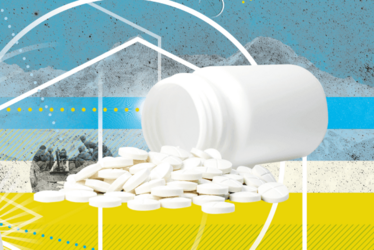Beyond the Pack
Serialized packaging is not the only way to deter counterfeiters – integrated authentication technologies are here to help

This article is part of our special focus on "traditional" pharma: The Small Molecule Manufacturer (read more here). You can find more articles from The Small Manufacturer here.

The counterfeit drug trade costs the pharmaceutical industry around $200 billion each year, but although the financial loss can be quantified, the impact of human life is much more difficult to measure. Counterfeiters exploit our basic human need to access essential medicines. And whether they are targeting patented drugs or generics, manufacturers of fake drugs have developed sophisticated ways to exploit consumers’ vulnerabilities. Counterfeiters have an arsenal of techniques that they rely on to dupe consumers – and their experience in making fake products means that they aim to copy the shape, color, and size of various medicines. The active pharmaceutical ingredient (API), however, may be at the wrong strength, not present at all, or be a completely different active ingredient or even toxic material.
Parallel trade is one opportunity for counterfeiters to slip their product into the supply chain. This process allows them to introduce medicines to markets where the demand for them is high while inflating their prices to capitalize on patients’ needs. Without a doubt, this type of illicit activity puts a strain on the relationship between pharmaceutical companies and customers.
The pharma industry has introduced serialization initiatives to counter counterfeits. Companies need to adhere to the Falsified Medicines Directive (FMD) in Europe and provide unit level traceability by 2023 per the Drug Supply Chain Serialization Act (DSCSA) in the USA. Both legislative measures rely on the use of 2D barcodes to verify product authenticity, but barcodes are easily copied and restricted to packaging, which can be discarded or reused. The problem is compounded by the fact that under legislation like FMD, the initially scanned pack is considered to contain an authentic drug product, which is not always the case. And even though pharmaceutical stakeholders and the companies who provide track and trace services are continually looking for ways to prevent the entry of such products into the supply chain, their efforts, much like the legislation for supply chain management and visibility, are focused on the developed world. Though counterfeiting undoubtedly occurs in the West, it certainly does not affect the region and its supply chains with the same detrimental effects experienced by developing countries (1). The cost of compliance with serialization can be prohibitive for many emerging nations, with most expected to develop their own policies, serialization standards, infrastructure, and implementation timetable. The high stakes situation means that pharma must look beyond packaging and begin to consider how security can be integrated into drug products themselves to better protect patients.

Integrated trust
Digitalization of physical tablets helps close the gaps in the supply chain by giving companies the power to track and trace individual tablets, regardless of whether they are within a pack or not. In 2019, in collaboration with PwC Australia and TruTag Technologies Inc., a tagging system was developed that connects physical tablets with Trillian – Google’s scalable and cryptographic ledger system. The tags, made of silicon dioxide, contain nanopores that reflect very specific spectral patterns when scanned, essentially acting as edible barcodes. Silicon dioxide is recognized by the FDA as a Generally Regarded as a Safe (GRAS) agent and is currently used in various medicines and pharmaceutical products. The taggants are, therefore, safe to add to batches of tablets as part of the film coating system.
The technology can also actively engage patients in the authentication process as they can simply download a mobile application to scan their tablets and verify their legitimate status; plus provide patient information in a digital format. Information from the authentication application is then automatically transferred to Trillian, allowing companies to gain real-time information and identify instances of counterfeiting, diversion, and illicit trade. Not only can this type of approach help companies save money, that would otherwise be lost to counterfeiting, but it also establishes a stronger line of communication and trust with end-users, as many will be saved from potentially harmful incidents.
The FDA has also published additional guidance on physical-chemical identifiers, or PCIDs (substances that contain unique physical or chemical properties to authenticate drug products), in solid dosage forms (2). The guidance, which covers PCIDs includes inks, pigments, flavors, and molecular taggants and informs manufacturers of the design considerations that must be made, and the supporting documentation required for the regulatory submission of such products. The existence of such guidance seems to suggest that, though the FDA is in support of more conventional serialization methods, they also recognize they are not comprehensive solutions. Adding additional layers of security, particularly at the dose form level, should be of interest to all pharmaceutical stakeholders who seek to improve the integrity of their supply chain and protect patient health and safety.
By incorporating microtags, the pill itself effectively becomes a barcode which can be digitally read and recorded, providing instant authentication. Colorcon’s SoteriaRx on-dose authentication platform, provides a powerful tool for tracking medicines from plant to patient and provides a level of supply chain authenticity and transparency not previously available. The digitalization of medicines represents a major step forward in the fight against unauthorized and illegitimate pharmaceutical production and provides an opportunity to safeguard patients.
- WHO, “1 in 10 medical products in developing countries is substandard or falsified”, (2017). Available at bit.ly/3eHkZlN
- FDA, “Incorporation of Physical-Chemical Identifiers into Solid Oral Dosage Form Drug Products for Anticounterfeiting”, (2011). Available at bit.ly/2Y52TDJ



















